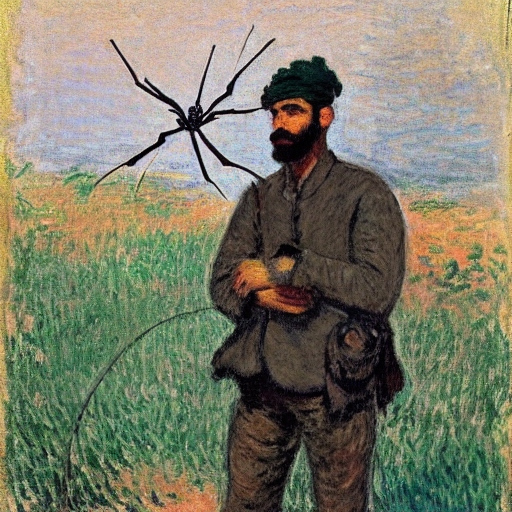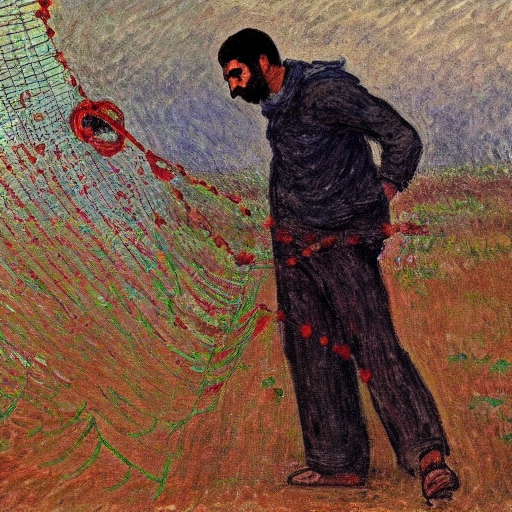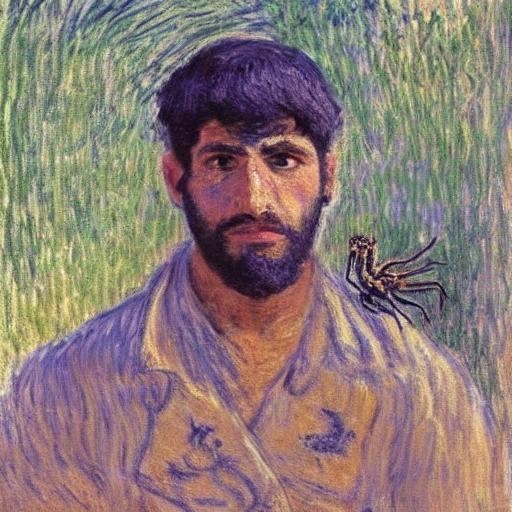Edition created by Fedaa Alsoufi
This page presents the editorial materials but not the story “Nothing”, which is not yet in the public domain. For the full edition, you must complete this form and then use the password you receive to access the edition here.
Table of contents
- Basic Information
- Interpretive Essay
- Translator Statment
- “Nothing” by Ghassan Kanafani (annotations only)
- Creative Responses
- Appendix
- License
Basic Information
Author: Ghassan Kanafani
Language: Arabic
Genre: Collection of short stories
Short Story: Nothing
Publication date: 1962
Interpretive Essay
Yaffa is a coastal city in historical Palestine renowned for its delicious oranges1. In the collection of short stories the “Land of Sad Oranges2,” by Palestinian novelist, short-story writer, and dramatist Ghassan Kanafani3, the “Sad Oranges” symbolize themes of exile and loss.
Trauma, a persistent wound that demands continuous collective effort to heal, forms the central theme of Ghassan’s narrative in “Nothing”: the story I chose to translate. Through the symbolism of a spider web being built and torn multiple times, Ghassan conveys the enduring struggle of the protagonist and the ever-present nature of intergenerational trauma. In a manner reminiscent of the protagonist in Lu Xun’s “Diary of a Madman,” the main character in “Nothing” grapples with mental health issues, rendering him an unreliable narrator. This unreliable perspective raises doubts about the credibility of his words, forcing readers to question the authenticity of his experiences.
On the other hand, the story highlights the stigmatization of mental health in Palestine, where seeking help for mental health issues is often met with misunderstanding and discrimination. This attitude towards mental health is unfortunately prevalent in many societies, including Palestine. The consequences of stigma can be severe, leading to isolation and a reluctance to seek help. The region still faces challenges in overcoming the stigma associated with mental health. In fact, pursuing a career in psychiatry can be looked down upon by those with higher degrees. Additionally, the trauma of the Nakba, meaning “catastrophe” in Arabic,4 continues to affect subsequent generations due to a lack of efforts to heal or address the trauma. The unresolved trauma is a lingering issue that continues to pile up over generations.
The narrative unfolds with an intentional juxtaposition of knowing and not knowing, as the story of a Palestinian freedom fighter in exile sets the stage for unexpected events. The newspaper headline, providing minimal information, leaves readers to piece together the significance of the event on their own. In terms of dialogue, Ghassan employs a concise and purposeful style, with the main characters taking turns responding to each other, often disregarding or sidestepping questions posed by the nurse in the case of the freedom fighter. This approach contrasts with the lengthy self-defense dialogues found in Honoré de Balzac’s “Sarrasine,” emphasizing the tension and brevity of the exchanges. Ghassan’s unique writing style is characterized by symbolic depth communicated through minimal words. In contrast to Gibran Khalil Gibran’s use of beautiful language and extended sentences to address social issues as seen in “Madame Rose Hanie”, Ghassan chooses a more restrained approach, avoiding the romanticization of the plot. The expectations of a friendly and caring relationship between the protagonist and the nurse are challenged, mirroring the complexities seen in “The Yellow Wallpaper” by Gilman and “The Judgment” by Kafka.
Kanafani uses the technique of defamiliarization5 to highlight a specific aspect of the social problems faced by Palestinians after being forced to leave their land on May 14, 1948, the start of the ongoing Nakba. Defamiliarization is usually described as a “destabilizing process”6 that prompts readers to question their habitual perception of reality and gain a deeper understanding of it. By employing this technique, Ghassan avoids presenting the story in a straightforward, report-like manner that might be less engaging to readers. Instead, he creates an intriguing and captivating narrative that draws readers in and encourages them to explore the deeper meanings of the story.
The use of the spider as a symbol in the novel is also an example of intertextuality between the original text and the Holy Quran7. In Islamic beliefs, spiders are seen as a sign of evil being woven, but they are also considered weak creatures that will eventually perish. By employing this symbolism, Ghassan conveys the protagonist’s feelings of turmoil, bafflement, and uneasiness while also suggesting that these feelings are temporary and will not last. The return to the Homeland is inevitable, and just as the spider’s web will eventually be destroyed, so too will the protagonist’s troubles come to an end.
Throughout the story, the protagonist is haunted by the image of a spider knitting its web in between his eyes. This symbolizes the pervasive sense of danger and instability that the protagonist and the wider Palestinian refugee population face. Additionally, it is a means to showcase how trauma can become internalized and lead to impacts on one’s mental state. By presenting the spider symbol in a literal and tangible way, Kanafani forces us to confront the psychological impact of displacement and loss.
Rather than presenting dialogue in a traditional format, Kanafani chooses to end most of his sentences with multiple dots, implying that there is more to be said. This creates a sense of uneasiness and disorientation for the reader, mirroring the way in which refugees often feel disconnected from their surroundings and unsure of their place in the world and their yearning for their homeland which they can no longer return to. By destabilizing the traditional format of dialogue, Kanafani emphasizes the destabilizing effects of the Nakba and the difficulty of finding a sense of belonging in a new place for Palestinian refugees. In my translation, I chose not to end the sentences with full stops to maintain a similar style.
Moreover, Kanafani uses defamiliarization to challenge the reader’s assumptions about refugees and their experiences. Instead of presenting the protagonist as a heroic figure or a victim, Kanafani portrays him as a complex and flawed character. The protagonist’s breakdown and successive firing of his gun challenge the reader’s assumptions about the role of refugees in the struggle for liberation and highlight the psychological toll of this struggle.
Notably, the narrator in the story maintains a distanced perspective, acting as an observer of events from afar. Interestingly, the narrator appears closer to the spider, becoming an agent that sheds light on the spider’s actions, thus accentuating the narrator’s detachment from the main character.
In conclusion, through his use of the spider symbol, fragmented dialogue, complex characterization, and various narrative elements such as trauma, unreliable narrators, knowing and not knowing, concise dialogue, unique writing style, character relationships, surprising symbolism, and a distant narrator, Kanafani skillfully employs defamiliarization to convey the experiences of Palestinian refugees, highlighting the psychological trauma of the Nakba and the enduring nature of healing. By forcing readers to engage with the destabilizing effects of displacement and loss, Kanafani creates a powerful and poignant portrait of the human cost of the ongoing Nakba, offering a thought-provoking exploration of the complexities of human experiences and the quest for healing.
Translator Statment
Translating is a challenging task that goes beyond one’s linguistic knowledge, often leaving one feeling constrained by language proficiency. It is tempting to opt for a literal word-for-word translation, but this approach can be frustrating and unsatisfying when it fails to capture the essence of the original text.
I chose to translate Ghassan Kanafani’s work because he doesn’t lend himself to easy categorization. He was a multifaceted figure, revered among Palestinians, allies, and those interested in Palestine, but not as a singular persona. He was a Muslim, a Marxist revolutionary, a party spokesperson, a novelist, a political theorist, a schoolteacher, an artist, a newspaper editor, and a committed internationalist. Kanafani’s anger at the injustices faced by Palestinians fueled his writing, and “Nothing” is no exception. Growing up, I encountered his works both in school and beyond.
I remember vividly analyzing Ghassan Kanafani’s famous novella “Men in the Sun” during an Arabic Literature class in fourth grade. It was a formative experience that introduced me to the profound themes of masculinity, exile, and loss present in his work. Kanafani’s writings resonated deeply within me and had a significant impact on the development of my conscience and writing. His ability to capture the complexities of Palestinian experiences left a lasting impression on me, fueling my passion for sharing Palestinian voices and narratives. Through my translation and adaptation of Kanafani’s work, I strive to honor his legacy and bring his powerful storytelling to a broader audience. For far too long, Palestinian voices have been marginalized and silenced by contemporary and mainstream media. Rather than portraying them as victims of ongoing post-colonial oppression and apartheid, they have been unjustly labeled as terrorists and denied their basic human rights.
The term “adaptation” derives from the Latin word “adaptatio,”8 which implies transformation, adjustment, and appropriation. I consider my translation as a form of adaptation—adjusting and transforming the original text to make it accessible to an audience who might struggle to access it in its original form. By translating Ghassan Kanafani’s words into English, I contribute to preserving what might otherwise be forgotten literature while adapting narrative strategies for modern-day readers. I aim to build a bridge between cultures that may seem worlds apart, using the power of words.
I endeavored to be creative in my word choices to maintain the artistic qualities and rhythm found in Arabic. In Arabic, nearly every word is built upon a three-letter or four-letter root, and throughout history, Arab authors have skillfully constructed sentences using words sharing a common linguistic root, resulting in a melodic flow. However, I must acknowledge that my limited knowledge of the English language may have hindered my attempts to achieve this.
In my translation, I made the decision to retain certain Arabic words because I felt unable to capture their essence in a single English word. I believe this choice also serves as an opportunity to expose English readers to Arabic and enrich their understanding of the Palestinian dialect. I am not a professional translator, and like any other individual, I have my own biases. What may seem right to me could be fundamentally wrong in the eyes of others.
While reading “Bliss” by Katherine Mansfield, I was inspired to include in-text comments to make the story’s flow less complex and more accessible to readers encountering it for the first time. Additionally, I took inspiration from the translator of “Madame Rose Hanie” by Gibran Khalil Gibran and used semicolons to combine two sentences, indicating a shift or change in tone. Arabic behaves in a distinct manner, often combining sentences with a comma, but I recognized that this might be unfamiliar to English readers. Furthermore, Arabic grants authors the freedom to expand on their ideas, resulting in long, seemingly endless sentences.
Throughout the translation process, I made a series of deliberate choices. For instance, at the beginning of the story, I opted to use “neurological rehabilitation hospital” in the newspaper headline to maintain consistency with the original text, although “rehab center” would have been a simpler alternative. Additionally, I inserted a line break between the headline and the story to clearly demarcate where the actual narrative begins.
In the timeline of the story, specifically during the dialogue, there is a mention of meeting another person referred to as “Al-Ra’ees” in the original Arabic text. This term can encompass various meanings such as president, manager, chief commander, or director of the hospital. While the original text did not explicitly specify the exact role of this person, I chose to translate it as “manager” for the sake of simplicity and generality.
Arabic often employs excessive words to describe simple actions, such as the act of stopping. In the original text, stopping for a while was described as “stabilizing one’s legs to the ground.” I felt that this phrasing unnecessarily complicated the description. Consequently, I opted for simpler language to convey the action more directly.
In this translation, I decided to keep the word أوف “ouf” in Arabic because in some dialects, including the Palestinian dialect, “ouf” can be used to express frustration or impatience. By retaining this Arabic word, I aimed to preserve the cultural richness and authenticity of the original text. It serves as a reminder of the intricacies and nuances that exist within languages, allowing readers to engage with the story on a deeper level.
In conclusion, translating a work requires making a myriad of decisions that strive to maintain the essence of the original while adapting it for a new audience. Throughout the translation process, I encountered challenges in capturing the nuanced meanings and expressive qualities of the Arabic language in English. However, I remained committed to conveying the story’s emotions and themes faithfully.
The act of translation is an intricate art that requires balancing linguistic accuracy, cultural sensitivity, and the intention to captivate readers. While my translation may not be flawless, I hope it serves as a testament to the resilience and power of storytelling, as well as the ongoing need to amplify marginalized voices and narratives, such as those of the Palestinians.
In the end, I view my translation as a humble contribution to preserving my identity and narrative while sharing literature that might otherwise be forgotten, which is also a platform to encourage cultural exchange and understanding between diverse readerships.
“Nothing” by Ghassan Kanafani (annotations only)
… the Occupied Lands9 …
… “ouf”10 …
… they diagnosed you based on your answers11 …
Creative Responses




Adaptations of literary works have always been an intriguing subject of study in the field of literature. As I was creating a creative response to “Nothing” by Ghassan Kanfani, I grappled with the challenge of highlighting both the freedom fighter and the spider, symbolizing their interconnectedness. In this pursuit, I deemed it crucial to feature the spider on the cover, as its enigmatic presence possesses the potential to captivate readers and ignite their curiosity.
However, I found the inclusion of the nurse on the cover to be unnecessary and potentially misleading. While the nurse does play a role in the story, his prominence on the cover might convey the impression that he is a central character or the primary focus of the narrative. Such a representation could divert attention away from the protagonist’s profound journey and the deeper thematic explorations that are woven throughout the text. Therefore, I believe that a cover devoid of the nurse would have been more fitting, allowing the spotlight to shine solely on the essence of the narrative.
As I delved further into the process, I pondered how to maintain consistency while capturing the distinct aesthetics associated with Kanafan. His works exude a simplistic yet timeless quality, with an air of antiquity. It was my aim to pay homage to Kanafani’s artistic sensibilities by designing a visual representation that resonates with his style, evoking a sense of familiarity and nostalgia.
In her book “A Theory of Adaptation,” Linda Hutcheon12 underscores the idea that “adaptations are haunted by their adapted texts.” I absolutely agree with this view because the artwork I produced cannot stand on its own without the original text. The images I created are undoubtedly a “second-degree” (to use Gérard Genette’s terms) form of the original text.
Hutcheon and O’Flynn discuss Virginia Wolf’s criticism of the “simplification” of literary works through visual means. Wolf described this transformation as a “parasite,” suggesting that it feeds off the original work and reduces its complexity. However, I disagree with Wolf’s view when it comes to reducing the complexity of the original text. Instead, I believe that transforming a literary work into a visual medium, such as a film or a graphic novel, can make the original work more accessible to modern-day readers. Today’s readers tend to “judge a book by its cover,” and an attractive cover can attract readers. Similarly, adapting a literary work into a visual medium can appeal to new audiences who may have found the original work too complex or intimidating.
To illustrate this point, I attempted to generate artwork based on a short description of the translated short story using DeepAI13, an online tool that creates artwork based on a short description. However, when I inputted the complete translation, the tool detected violent content and only paid accounts could access the unfiltered content. Therefore, I used a shorter version of the description that was less revealing of the events but still conveyed the same message.
When using description 2 (see appendix), I was unable to generate photos when including the line “and fired his gun randomly.” Removing it and choosing the fantasy style led to generating photos that all had a newspaper included at the center of the artwork which I think was irrelevant to the story.
By incorporating elements inspired by Palestinian artists and visually representing the connection to the land, I aimed to reinforce the narrative’s cultural authenticity and evoke a deeper emotional resonance within the readers. Art in the Levant14 region is characterized by its abstract and minimalistic nature, often drawing inspiration from the shapes and colors found in nature. Among the prominent Palestinian artists is Ismail Shammout15, an iconic figure in post-1948 Palestinian Art. While I do not seek to imitate his style directly, I find inspiration in Shammout’s work due to the shared beliefs and views he held with Ghassan Kanafani regarding the occupation. It is my belief that Kanafani would have acknowledged and appreciated Shammout’s artistic endeavors.
Taking cues from the artistic traditions associated with Kanafani’s work, I decided to adopt an “impression and painting” style in the translation process. This style aligns more closely with the visual aesthetics commonly found in connection with Kanafani’s literary pieces. As a result, I created the first attached image, intending to evoke a sense of the visual atmosphere intertwined with the narrative.
Although I did not explicitly mention the specific setting of the story, it is important to note that the AI model, being sourced from online information, inherently carries biases. Nevertheless, it coincidentally chose an open field as the backdrop for the image. This choice holds significance as the majority of Palestinians traditionally have an agricultural background16, cultivating a deep and intimate connection to their land. The depiction of an open field symbolizes the profound ties Palestinians have to their homeland, their struggle to maintain it, and the resilience they embody in the face of adversity.
While the initial artwork generated during my first draft (see pictures 3 and 4) captured the essence of the story effectively, subsequent attempts to generate similar results proved challenging. The ever-evolving nature of AI models makes it difficult to replicate previous outcomes. Despite using a similar story description, the artwork generated this time (see pictures 1 and 2) failed to capture the different elements of the narrative as well. This discrepancy is somewhat disappointing to me, highlighting the unpredictable nature of AI-generated art.
The takeaway from this creative response is that this story is not easily digestible in one sitting or with a single read. The unsettling image of the spider’s web wrapped around the main character’s eyes serves as a stark reminder that the story delves into violent language, acts, and mental health topics. However, the innocence portrayed in the protagonist’s facial expression is intentional, as I want readers to sympathize with him and acknowledge the humanity he deserves. Palestinians have long been stripped of their humanity, and it is crucial to restore it through compassionate engagement with their narratives.
In conclusion, while Virginia Woolf’s criticism of simplifying literary works through visual mediums may hold some truth, I firmly believe that the benefits of adaptations outweigh the drawbacks. Transforming literary works into visual representations can attract a new audience, provide fresh perspectives on the original text, and shed light on different themes and ideas present in the narrative. Ultimately, these adaptations enhance the overall experience and understanding of the work.
Appendix
Description 1
The text “Nothing” by Ghassan Kanafani tells the story of a freedom fighter who was taken to a neurological rehabilitation hospital after firing his gun at the Occupied Lands. The freedom fighter heard the term “breakdown” for the first time and asked the nurse what it meant. The nurse explained that it meant he was not okay. The freedom fighter then asked if the breakdown was in his head, to which the nurse replied that it was most likely. However, the freedom fighter insisted that his breakdown was in his chest, not in his head and that it was a military case because he was a freedom fighter. The nurse took him to meet the manager, but the freedom fighter complained that he was exhausted and needed to rest. The nurse refused to let him rest and continued to pull him violently. The freedom fighter then talked about firing his gun and how he felt nothing after firing the bullets. The nurse then informed him that he had killed two people. The freedom fighter did not deny it and asked what the difference was between a breakdown and someone who intended to kill. The story ends with the spider web falling apart and him trying to reconstruct it.
Description 2
The story begins with a newspaper headline reporting that a Palestinian freedom fighter had a breakdown. By employing the symbol of the spider, Ghassan conveys the protagonist’s feelings of turmoil, bafflement, and uneasiness while also suggesting that these feelings are temporary and will not last. The return to the Homeland is inevitable, and just as the spider’s web will eventually be destroyed, so too will the protagonist’s troubles come to an end.
License
As of 2024, the text of “Nothing” is not yet in the public domain.
All editorial material by Fedaa Alsoufi is licensed under CC BY-NC 4.0
- https://en.wikipedia.org/wiki/Jaffa_orange↩︎
- http://www.nobleworld.biz/images/sad_orange.pdf https://en.wikipedia.org/wiki/The_Sad_Orange_Land↩︎
- https://en.wikipedia.org/wiki/Ghassan_Kanafani↩︎
- https://decolonizepalestine.com/intro/the-mandate-years-and-the-nakba/ https://news.un.org/en/story/2023/05/1136662↩︎
- https://www.asjp.cerist.dz/en/downArticle/24/18/2/175022↩︎
- https://blog.homeforfiction.com/2020/05/11/defamiliarization-in-literature-examples-how-to-use/↩︎
- https://quran.com/al-ankabut↩︎
- https://journals.openedition.org/lisa/2897↩︎
- Refers to Historical Palestine specifically Palestine before 1948.↩︎
- Used in Palestinian dialect to express frustration↩︎
- The original text literally says “They know the disease from your answers.”↩︎
- https://books.google.com/books/about/A_Theory_of_Adaptation.html↩︎
- https://deepai.org/↩︎
- https://en.wikipedia.org/wiki/Levant↩︎
- https://www.al-fanarmedia.org/2021/05/palestinian-art-proclaims-a-peoples-identity-in-the-conflict-with-israel/↩︎
- https://socialsciences.mcmaster.ca/kubursi/ebooks/water.htm↩︎
